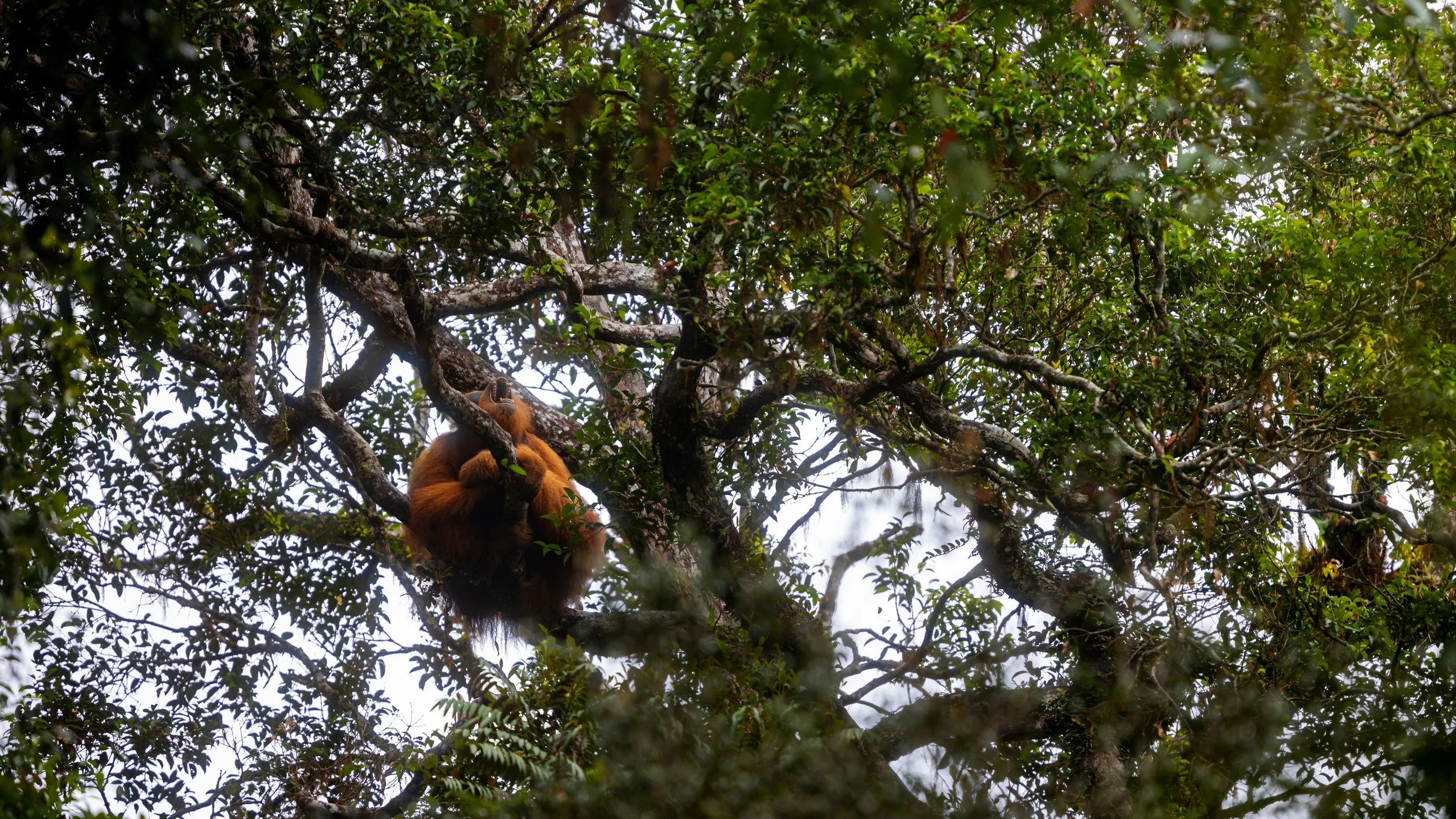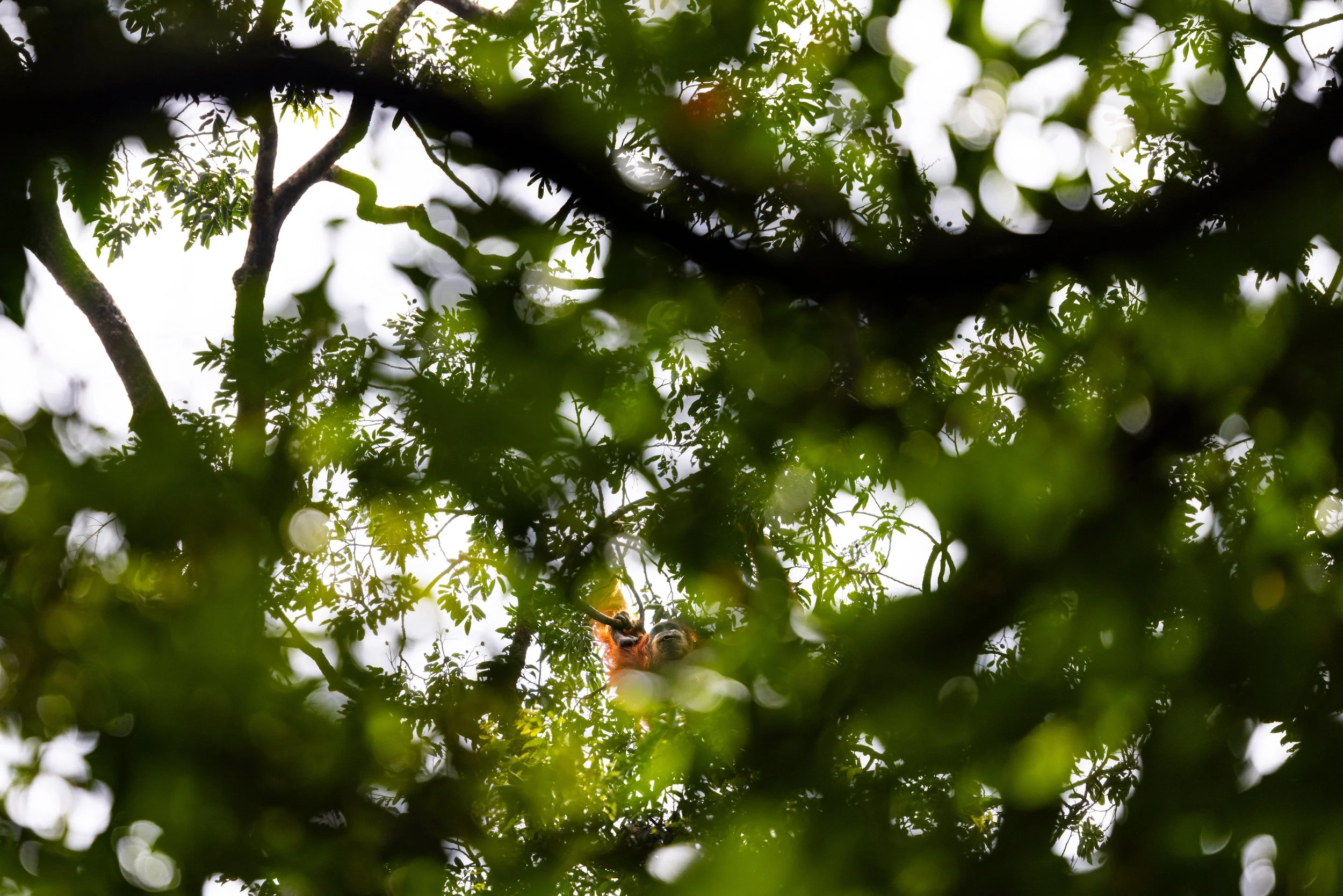The Alpha Male
CANON EOS R5, f/4, 1/125, ISO 200 with CANON 400mm f/2.8 IS USM + CANON EF EXTENDER 1.4 III
I captured this photo during an expedition to the remote Kapi area within Gunung Leuser National Park, in northern Sumatra, Indonesia. It was one evening, just over half an hour from the destination where we would set our camp that we spotted this alpha male Sumatran orangutan (Pongo abelii) resting high in a large tree across a stream.
Battling the condensation that had formed inside my lens because of the humidity, the rain, and the river crossing earlier that day — which is still visible in the lower part of the image — I managed to capture this moment as the orangutan let out a massive yawn.
Adult male orangutans achieve “alpha” status through a mix of physical strength, social charisma, and their ability to establish dominance over other males within their territory. Alpha males develop prominent cheek pads, known as flanges, which not only make them appear more imposing but also serve as symbols of maturity and authority. They emit deep, resonating calls that can echo across kilometers of forest, marking their territory and attracting females, which also helped us track them on other occasions.
Despite their dominant role, alpha males are not constantly aggressive. They can show gentleness and patience, especially with young orangutans or familiar females. Alphas tend to be more sedentary than other individuals, often resting high in the treetops when unthreatened. However, their position is never secure, as rival males continually challenge their authority.
Gunung Leuser is one of the last natural habitats of the Sumatran orangutan, one of the three remaining orangutan species. Fewer than 14,000 individuals are believed to remain in the wild, and the park is vital for their survival. Here, orangutans roam freely, moving slowly through the forest canopy, building a new nest each night and feeding on fruit, shoots, insects, and occasionally small vertebrates. This species is reported to be one of the few mammals that use sticks as tools to get food, such as termites.
In addition to orangutans, the park is home to five other primate species: the white-handed gibbon (Hylobates lar), known for its iconic calls; the siamang (Symphalangus syndactylus), the largest of the gibbons; the pig-tailed macaque (Macaca nemestrina); and the endemic Thomas leaf monkey (Presbytis thomasi), easily recognized by its upright crest and funny face. These species play crucial roles in seed dispersal and maintaining the ecological balance of the forest.
Even if conservation laws are working, Sumatran orangutans are critically endangered due to deforestation, poaching, and habitat fragmentation. Protecting them means not only saving an iconic species but also safeguarding the health and biodiversity of the forests they inhabit.
After a few minutes, Ardy, Rasman, and Ervin continued to build the camp for the night so we wouldn’t risk arriving after sunset without a safe place to stay. With Udin and Karim, we observed this individual for about an hour as he eventually moved a few meters to skillfully weave two branches into a nest. Unfortunately for me, the visibility was blocked by a branch in front of me that Karim tried to move by climbing the trunk, but without full success. Then the orangutan settled in for the night, and we continued on to the camp.
Gunung Leuser National Park is one of Southeast Asia’s most important and biodiverse ecosystems. Spanning more than 7,900 km², it stretches across the mountainous rainforests of Aceh and North Sumatra provinces. The park is named after Mount Leuser, one of the island’s highest peaks. Recognized as a UNESCO World Heritage Site as part of the Tropical Rainforest Heritage of Sumatra, Gunung Leuser is one of the last intact refuges for many rare and iconic species on Earth.
Beyond its role in biodiversity conservation, the park also plays a crucial part in protecting water resources and regulating the climate for millions of people living in Sumatra. However, it is under constant threat from illegal logging, palm oil expansion, and unsustainable infrastructure development.
In addition to primates, the park shelters large mammals such as the critically endangered Sumatran rhinoceros (Dicerorhinus sumatrensis), the elusive clouded leopard (Neofelis diardi), the Sumatran elephant (Elephas maximus sumatranus), and, most famously, the Sumatran tiger (Panthera tigris sumatrae). All of these species are listed as critically endangered by the IUCN Red List.
The park also hosts more than 380 bird species, as well as a wide variety of reptiles and amphibians, and an extraordinarily rich flora that includes thousands of plant species—among them the Rafflesia arnoldii, the world’s largest flower





